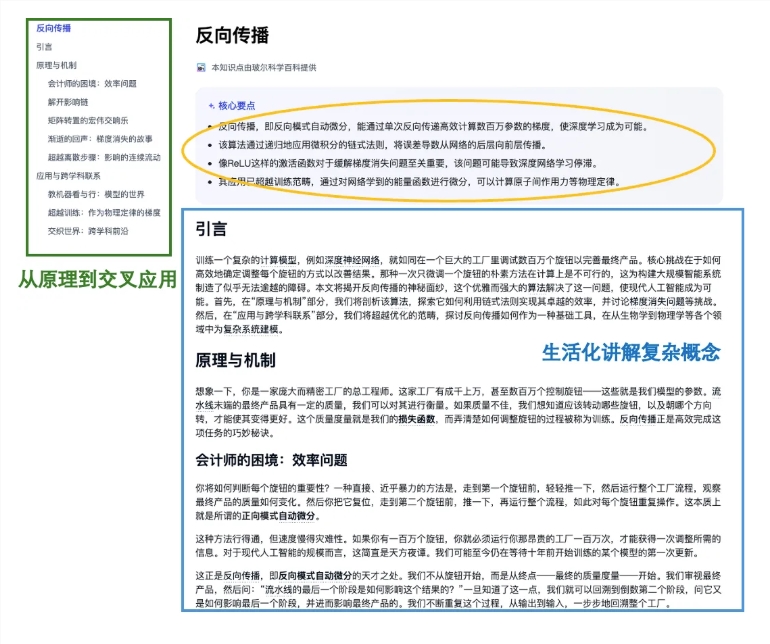When Wikipedia stops at listing entries, and when AI encyclopedias fall into the illusion of facts, a true intelligent knowledge platform for scientific learning—SciencePedia—is set to revolutionize the way knowledge is acquired, with "deep understanding" at its core. Developed by DeepModel in collaboration with multiple top research institutions, SciencePedia does not just aim to "answer questions," but to reveal the logical structure and evolutionary process behind knowledge, allowing learners to truly "understand how science thinks."

From Definition to Context: Knowledge Is No Longer an Island
Searching for "backpropagation" on traditional platforms might only yield a technical definition; on SciencePedia, you will see a dynamic knowledge graph:
Historical origins: from the adjoint method in control theory in the 1970s, to the key breakthrough by Rumelhart et al. in neural networks in 1986;
Principle evolution: how the chain rule is efficiently applied to gradient computation, and why it became the cornerstone of deep learning;
Associative network: the deep connections with optimization algorithms, loss functions, and overfitting problems;
Interdisciplinary extensions: analogies in physics' variational principles and biological feedback mechanisms.
This "Long Chain-of-Thought" presentation approach allows users to naturally build cognitive frameworks without rote memorization, instead engaging in causal logic.

Reverse Tracing + Multidimensional Correlation: How AI Teaches You to Think
The core engine of SciencePedia integrates "Inverse Chain-of-Thought Search" technology: when a user asks a question, the system not only reasons forward to answer it, but also traces backward to identify the fundamental concepts, prior knowledge, and potential misconceptions underlying the question, automatically generating a multidimensional knowledge network. For example, when learning about the "Transformer architecture," the platform will automatically connect linear algebra, attention mechanisms, and sequence modeling modules, and highlight common misunderstandings.
This design is especially suitable for interdisciplinary learning—physicists can quickly grasp machine learning tools, and biologists can understand computational modeling logic, truly breaking down disciplinary barriers.
Human-Machine Collaboration: AI Handles Efficiently, Experts Ensure Accuracy
To balance efficiency and accuracy, SciencePedia adopts a dual-engine update mechanism:
AI Engine: Real-time captures the latest papers, textbooks, and authoritative databases to build an initial knowledge framework;
Expert Community: A review network composed of domain scientists, which deeply verifies, supplements, and iterates on key entries.
This model avoids the "illusion risk" of purely AI-generated content and overcomes the lag issue of traditional encyclopedias, ensuring that the content remains cutting-edge, accurate, and in-depth.
More Than Reading: A Personalized Learning Loop
SciencePedia further integrates an adaptive practice system and personalized learning path recommendations. After reading, users can immediately complete targeted exercises. The system dynamically adjusts subsequent content difficulty based on performance, and generates personalized knowledge maps, marking mastery levels and weak areas, achieving an integrated "learn-practice-test" process.
